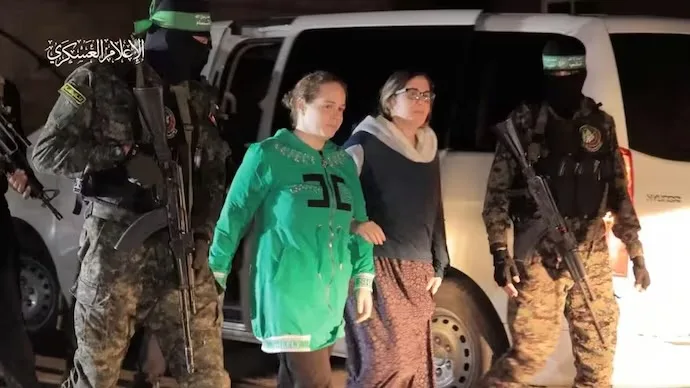Tunnels, Cages and Pits are The kind of things lived with the Israeli Gaza Hostages who were in captivity under Hamas siege.
Tunnels, cages, pits—these are the harrowing words used by the families of the final Israeli hostages, recently released from the Gaza Strip, to describe the grim conditions endured by their loved ones during their nearly two years in captivity.
With the last 20 surviving hostages freed as part of a US-brokered ceasefire agreement, relatives are now beginning to share the chilling details of the physical abuse, profound starvation, and psychological torment inflicted by their captors.
The accounts, relayed through the former captives to their families, paint a stark picture of life in Hamas’s underground labyrinth, revealing a brutal reality of confinement that included isolation, beatings, and being held in barely inhabitable spaces.
Captivity’s Nightmare:
Hostages Endure Tunnels, Cages, and Pits in Gaza
The liberation of the last surviving Israeli hostages from the Gaza Strip has brought with it shocking revelations of their ordeal.
Relatives are now bravely beginning to recount the dire conditions in captivity, describing a nightmare existence of forced confinement in dark tunnels, small wire cages, and underground pits—a testament to two years of hell endured by the captives.
These detailed testimonies of starvation and torture underscore the brutal psychological and physical trauma inflicted during their long isolation.
Headline Points
• Extreme Confinement:
Hostages were held in brutal conditions, including small wire cages where they could not stand and underground pits where they lacked enough air or room to sit.
• Physical Abuse and Torture:
Accounts detail severe torture, including being flogged and beaten with objects, being handcuffed and chained, and being subjected to psychological warfare.
• Starvation and Malnutrition:
Several hostages suffered prolonged starvation, with one losing between 30% and 40% of his body weight, and another was shown in a propaganda video digging his own grave while severely malnourished.
• Tunnel Life:
Many spent the majority of their captivity in dark, cramped tunnels with little to no access to daylight or fresh air, losing all sense of time.
• Latest Releases:
The details emerge following the release of the last 20 living Israeli hostages last week, completing a key phase of the US-brokered ceasefire deal.
Subhuman Conditions in Underground Mazes
The most disturbing reports centre on the subhuman spaces used for confinement.
Omri Miran, a father of two, was held in 23 different locations throughout Gaza. His brother, Boaz Miran, disclosed that at one point, five hostages were confined in a small wire cage measuring just 1.8 meters by 1.6 meters (six feet by five), where they were forced to remain bent over as they could not stand upright.
Even more horrifying were the accounts of being held in subterranean holes. Yosef Haim Ohana’s father revealed that his son spent several days in an underground pit with six other captives.
The space was so cramped that the seven men could not sit or lie down, forced to lean against the wall while standing, and suffered from a severe lack of oxygen.
Avinatan Or, who endured two years alone in captivity, was also subjected to isolation and torture. After attempting to escape, his father, Yaron Or, recounted that he was beaten and then confined to a wire enclosure—essentially a cage—that was scarcely bigger than a mattress.
Torture, Starvation, and Psychological Trauma
The physical suffering of the released captives extended far beyond confinement.

Family members have confirmed multiple instances of severe abuse and neglect:
• Physical Violence:
Rom Braslavski was reportedly flogged and beaten with objects over a period of months. Another former captive, Matan Angrest, was subjected to “very severe torture” during his initial months in captivity, which included being beaten until he lost consciousness, covered with black sacks, and dragged away.
• Chains and Confinement:
Hostages were often chained at their hands and feet for long periods, losing all sense of time and space in the dark tunnels.
• Malnutrition:
Prolonged periods of starvation were a consistent feature of the captivity. Avinatan Or lost between 30% and 40% of his body weight, according to initial medical examinations.
The severe deprivation was highlighted by a propaganda video released in August, showing Evyatar David severely malnourished and digging what appeared to be his own grave inside a tunnel.
• Psychological Warfare:
The captives were subjected to constant psychological torment, including being told lies by their captors that the Israeli army had given up on them or was actively seeking to kill them.
They also described the terror of being held underground while walls collapsed around them during Israeli bombardments.
While a Hamas official claimed that the hostages lived in the same conditions as their guards and received care, the detailed testimonies of the families stand in sharp contrast to this assertion, revealing systematic abuse.
As the former hostages begin their long road to recovery, requiring treatment for malnutrition, lack of sunlight, and profound trauma, their accounts provide a critical, albeit painful, glimpse into the dark reality of their two-year ordeal.
